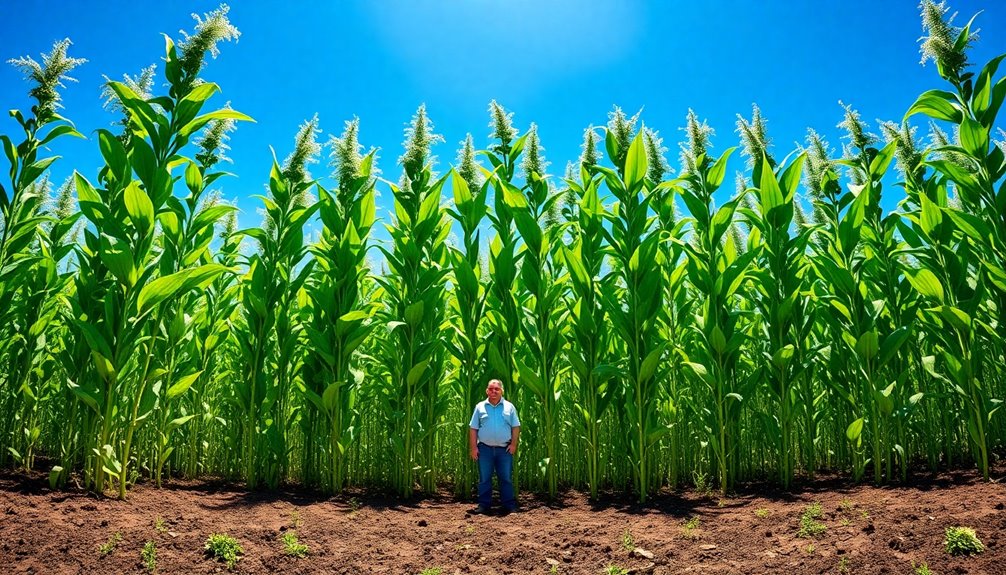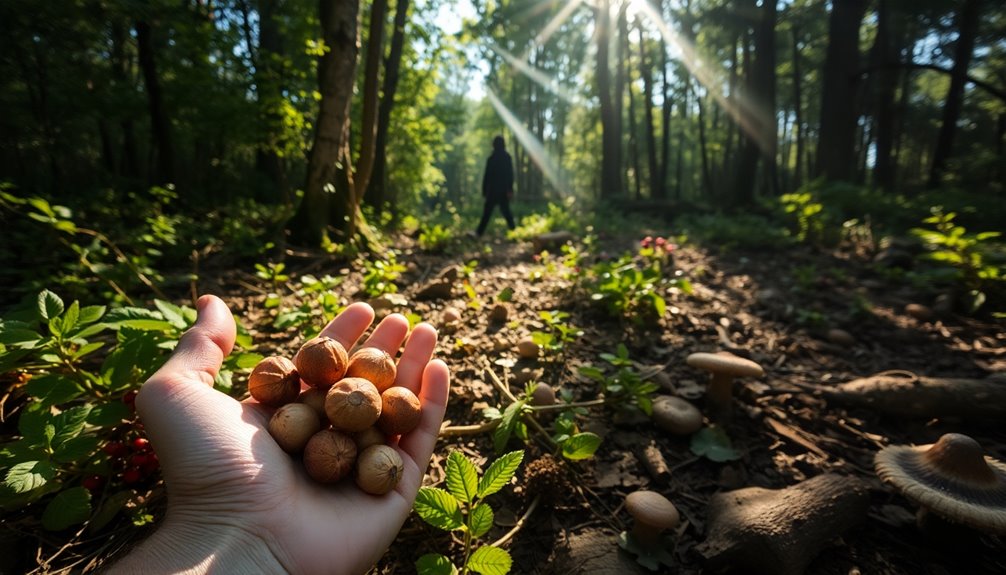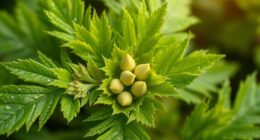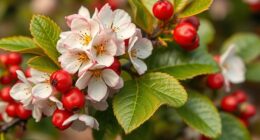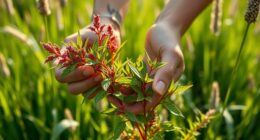Forage sorghum can grow impressively tall, typically ranging from 6 to 12 feet, depending on the variety and the conditions it's grown in. Its robust growth is influenced by factors like soil fertility, moisture, and temperature. With a strong root system, this giant grass efficiently accesses moisture, helping it thrive. As you consider adding forage sorghum to your fields, keep in mind that factors such as seeding techniques and harvest timing can impact its height and nutritional quality. You'll discover more about maximizing your forage sorghum's potential and benefits soon enough!
Key Takeaways
- Forage sorghum typically grows between 6 to 12 feet tall, depending on the variety and environmental conditions.
- The height of forage sorghum is influenced by factors such as soil fertility, moisture, temperature, and genetic traits.
- Brachytic dwarf hybrids have shorter internodes but still achieve good yields, contributing to the plant's overall height.
- The growth stages of forage sorghum impact its height and productivity, with early harvesting promoting rapid regrowth.
- Harvesting around 30 inches optimizes nutritional quality and palatability for livestock grazing.
Overview of Forage Sorghum

Forage sorghum is an impressive warm-season annual grass that offers farmers a robust option for livestock feed. Known for its tall stature, it can reach heights between 6 to 12 feet, depending on the variety and growing conditions. This fast-growing forage thrives in warm, fertile soils, making it an excellent choice for areas where corn production is limited.
The ideal planting depth for sorghum seeds is between 1 to 1.5 inches, and you'll want to guarantee soil temperatures exceed 60°F for rapid germination.
With proper management, forage sorghum boasts a significant yield potential, averaging between 10 to 15 tons per acre in Pennsylvania. This yield varies based on fertility management and environmental conditions.
To maintain prime growth and prevent excessive height, early and frequent harvesting is essential. Ideally, you should mow at a height of at least 4 inches to promote regrowth. Additionally, understanding the concept of diversification strategy can help farmers optimize their crop production and mitigate risks associated with relying solely on one type of forage.
Growth Characteristics

When it comes to forage sorghum, understanding height variation is key to optimizing growth.
You'll find that factors like soil fertility, moisture, and temperature all play an essential role in how tall your plants will grow.
Let's break down the growth stages and see how each stage influences overall height.
Height Variation Factors
Height variation in forage sorghum is influenced by a combination of genetic traits and environmental factors. Generally, you can expect this robust grass to reach a height of at least 5 to 12 feet, depending on the forage variety you choose. The growth habit, including branching at nodes and the development of tillers, plays a significant role in determining how tall your plants will grow.
Environmental conditions are vital; factors like soil fertility, moisture availability, and temperature directly impact the vigor and height of your forage sorghum. For instance, if your soil is rich in nutrients and you provide adequate moisture, you're likely to see taller plants. Conversely, poor soil fertility or insufficient water can stunt growth.
Additionally, some hybrids, such as Brachytic dwarf types, may have shorter internodes but can still yield well.
To maximize height potential in your forage sorghum, focus on ideal planting techniques and effective management practices. Proper fertilization and timely harvesting are essential to achieving the best results, allowing your forage sorghum to thrive and reach impressive heights.
Growth Stages Explained
Typically, forage sorghum progresses through distinct growth stages that greatly influence its characteristics and overall productivity. As you plant sorghum, you'll notice its growth habit resembles that of corn, with grooved stalks and alternating internodes. This structure allows it to thrive in warm, fertile soils, especially under ideal growing conditions.
During the early stages, forage sorghum develops a robust root system, which is crucial for accessing soil moisture conditions. The plant's height can range from 5 to 12 feet, depending on the variety and environmental factors. When temperatures hover between 75º to 85ºF, you're likely to see optimal growth.
As the plant matures, it can produce tillers, enhancing overall biomass. If you're considering sorghum-sudangrass hybrids, be prepared for even greater yields, often exceeding 5 tons per acre due to hybrid vigor.
The interplay of soil moisture, temperature, and fertility will ultimately dictate how tall your forage sorghum grows, making careful management essential for maximizing productivity.
Ideal Growing Conditions

Forage sorghum flourishes best in warm, fertile soils under ideal conditions. To achieve optimal growth, aim for soil temperatures ranging from 75º to 85ºF, with at least 60°F necessary for successful germination.
Additionally, well-drained soil is essential, as a soil pH between 6.0 and 6.8 promotes healthy crop development and productivity.
When planting, consider the seeding rate, which typically ranges from 7 to 9 lbs per acre. Plant your seeds at a depth of 1 to 1.5 inches to guarantee robust growth and establishment.
Forage sorghum is a nutrient-demanding crop, so you'll need to pay attention to its nitrogen requirement. Splitting nitrogen applications throughout the growth cycle can be beneficial, with a total requirement estimated between 100 to 150 lbs per acre.
Seeding and Planting Tips

When you're ready to plant forage sorghum, make sure your soil's well-drained and has a pH between 6.0 and 7.0.
You should aim for a seeding rate of 7 to 9 lbs per acre to achieve a healthy plant density.
Keeping these ideal soil conditions and seeding rates in mind will set you up for success.
Ideal Soil Conditions
To achieve the best results when planting forage sorghum, you'll want to focus on creating ideal soil conditions. For peak growth, guarantee your soil is well-drained, with a pH between 6.5 and 7.0, and temperatures above 60°F. These conditions help your seed germinate effectively and support the crop's growth.
Here's a quick reference table for the ideal soil conditions for forage sorghum:
| Soil Condition | Ideal Range |
|---|---|
| Soil pH | 6.5 – 7.0 |
| Soil Temperature | Above 60°F |
| Planting Depth | 1 – 1.5 inches |
| Seeding Rate | 7 – 9 lbs per acre |
| Nitrogen Requirement | 100 – 150 lbs over crop cycle |
Late planting can be done until July 4, giving you flexibility based on your environmental conditions. Additionally, higher plant densities can enhance forage utilization by reducing animal refusal of stem materials. Don't forget, proper soil fertility management is essential, much like with corn silage, so consider your nitrogen needs carefully for a successful forage sorghum crop.
Recommended Seeding Rates
Achieving ideal growth in forage sorghum largely depends on selecting the right seeding rate. The recommended seeding rates for forage sorghum are between 7-9 lbs per acre when planted in rows. If you're planting sudangrass, you'll want to increase that to 25-30 lbs per acre. This guarantees you achieve maximum germination while maintaining appropriate plant densities.
When planting, aim for a depth of 1 to 1.5 inches to promote strong seedling development. Remember, ideal soil conditions are vital, with a pH level between 6.0 and 7.0 and temperatures above 60°F for the best results.
Late planting opportunities exist until July 4, giving you flexibility in warmer regions.
Higher plant densities not only improve the overall growth of your forage sorghum but also help reduce animal refusal of stem materials, which enhances forage utilization.
Nutritional Benefits
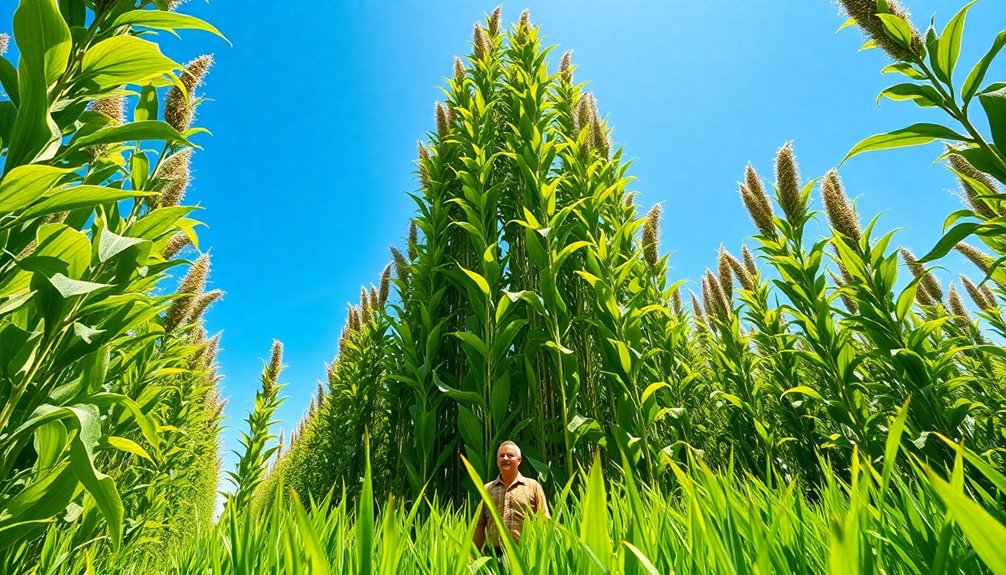
What makes forage sorghum a standout choice for livestock nutrition? This forage plant offers impressive nutritional quality that can greatly benefit your livestock. With an average crude protein content of 10-11%, well-fertilized young plants can even exceed 15%. This high level of protein is vital for supporting growth and overall health in animals.
Additionally, forage sorghum boasts total digestible nutrient (TDN) values greater than 67%, making it a highly digestible feed option. If you're considering sorghum hybrids, look for the Brown Midrib (BMR) genetics, as these can enhance fiber digestibility and potentially boost TDN values by 5-7 percentage points compared to conventional varieties.
Another advantage of forage sorghum is its juiciness and sweetness, especially in warmer conditions. This characteristic contributes to its appeal as a forage option, providing essential carbohydrates that help keep livestock energized during colder months.
Harvesting at around 30 inches not only maintains the plant's nutritional quality but also preserves its palatability for grazing animals. By incorporating forage sorghum into your feeding strategy, you can guarantee your livestock receive the nutrition they need to thrive.
Harvesting Techniques
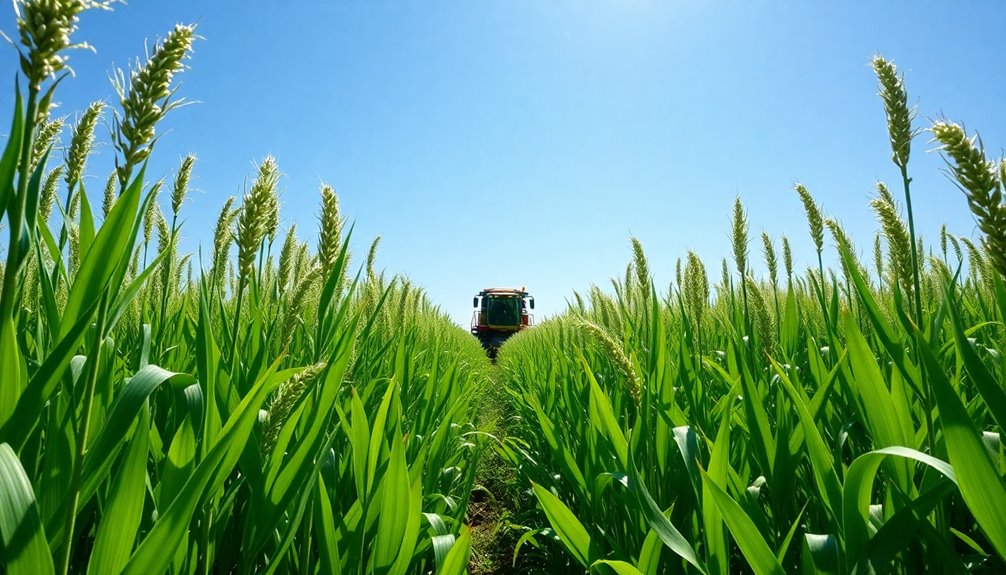
Harvesting forage sorghum at the right height is essential for maintaining its nutritional quality and promoting regrowth. You'll want to monitor growth closely to determine the ideal harvesting height, which is around 30 inches. Early and frequent harvesting is key; it helps prevent excessive growth and keeps nutrient quality intact. Aim to mow at least 4 inches high to encourage rapid regrowth.
Here's a handy table to guide your harvesting techniques:
| Technique | Description | Benefits |
|---|---|---|
| Early Harvesting | Cut before excessive growth occurs | Maintains quality and promotes regrowth |
| Wide Windrow Management | Create wide windrows during harvesting | Reduces moisture and retains nutrients |
| Limit Wheel Traffic | Minimize traffic over the field | Reduces crown damage and improves regrowth |
| Timing Before Frost | Harvest before frost sets in | Prevents prussic acid accumulation |
Economic Considerations
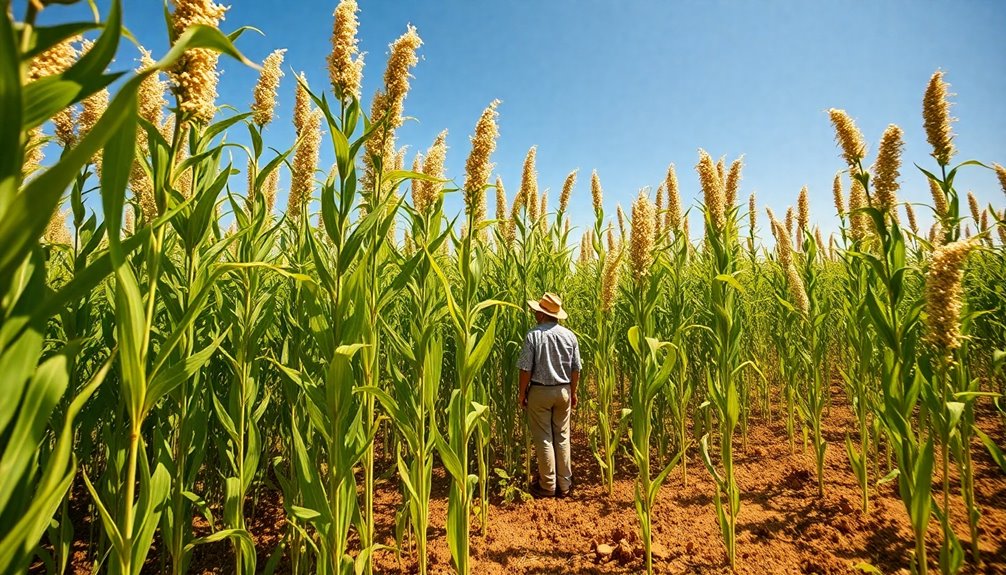
Maintaining the right harvesting techniques directly impacts the economics of forage sorghum production. With yields ranging from 4 to 12 tons of dry matter per acre, your profitability hinges on local market conditions and effective management practices.
By choosing forage sorghum, you might find that your production costs are generally lower than corn, making it an attractive option, especially in drought-prone areas with high summer yields.
Utilizing sorghum-sudangrass hybrids can further enhance your economic returns due to their superior yields and nutritional value. Implementing BMR varieties can provide additional benefits, making your forage even more appealing to livestock.
To maximize economic viability, consider on-farm feed utilization, particularly in the Upper Midwest, where securing a market before planting is crucial.
Additionally, effective management practices, including timely harvesting and proper grazing, can greatly influence your feed costs and livestock gains.
Frequently Asked Questions
How Tall Does Forage Sorghum Get?
When you're considering forage sorghum, you'll find it can grow anywhere from 6 to 12 feet tall, depending on the variety and environmental factors.
If you choose hybrids, you might see even more impressive heights due to their enhanced growth potential.
Keep in mind that ideal temperatures between 75º-85ºF greatly boost growth, and harvesting at least 30 inches guarantees quick regrowth while maintaining quality.
How Tall Is Sorghum Grass?
When you ask how tall sorghum grass is, you'll find it can grow between 4 to 12 feet, depending on the variety and conditions.
Factors like soil fertility and moisture play a big role in its height.
If you're considering planting, remember that ideal growth conditions, such as warm temperatures and well-drained soil, can really boost its potential.
What Is the Difference Between Grain Sorghum and Forage Sorghum?
Imagine walking through vast fields, with two types of sorghum towering beside you.
Grain sorghum stands proud for its seeds, while forage sorghum beckons with its lush, green leaves for grazing.
You'll notice that forage sorghum's bred for high protein and digestibility, perfect for livestock, while grain sorghum focuses on seed yield and drought resistance.
Each type serves a unique purpose, shaping how they're managed and harvested in your farming practices.
Does Sorghum Sudan Grass Come Back Every Year?
Sorghum sudangrass doesn't come back every year since it's an annual grass.
You'll need to replant it each growing season for ideal results. While it can self-seed under the right conditions, relying on that isn't recommended if you want consistent quality and yield.
If you want to maximize your forage production, it's best to replant sorghum sudangrass annually, ensuring you get the most out of your fields each summer.
Conclusion
To sum up, forage sorghum stands tall like a sentinel in your fields, ready to provide ample benefits. By understanding its growth characteristics and ideal conditions, you can cultivate this versatile crop successfully. With the right seeding and harvesting techniques, you'll not only enhance your soil but also boost your livestock's nutrition. Embrace the economic potential of forage sorghum, and watch your efforts flourish as you reap the rewards of this giant grass.

